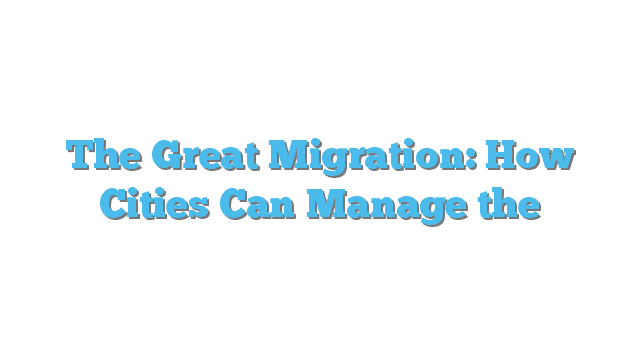The Great Migration: How Cities Can Manage the New Trend Toward Urbanization — Craig Catley, Director of StrategyBlocks, has a long history in helping organizations manage change. He unlocks what cities can practically do to build the right foundation for upgrading technology and handle the drain on resources recently experienced by the rise in urbanization.
Cities all over the world are consumed with how to be ‘smart.’ With a flood of new inhabitants in urban areas across the globe, municipalities realize the vital need for technology to address citizens in the most effective way possible, and to manage what is quickly becoming exponential growth. The global smart city market will be valued at US$1.565 trillion in 2020, and more than 26 global cities are expected to be ‘smart’ by 2025 (Frost and Sullivan).
According to the United Nations World Urbanization Prospects, six out of every ten people are expected to live in urban areas by 2030. What is the broader impact of this mass migration? How can these urban areas manage an influx of people and, with it, the challenges that come from added constraints on infrastructure and resources?
In the attempt to answer these questions, most governments come up against similar obstacles: disparate departments, limited budgets and an infrastructure that can’t compete with today’s digital demands. Cities are working to support massive populations with infrastructure that is hundreds of years old, and prudent fiscal investment, risk management and strategic execution management are becoming ever more critical.
Today’s governments are finding the need to transform to a more commercial model to manage performance, and ensure the consistency of service delivery to the population. In order to manage these issues and create true digital transformation, administrators must think like innovators — developing a comprehensive strategy that is capable of growing and adapting with the population and building a solution that most effectively uses resources at hand.
A Strategy to Connect
The first and most vital necessity to any ‘smart’ development is that of connectivity. In an IOT world, connectivity is king. There is the obvious need for robust WiFi connectivity that enables devices to communicate, gather data and run in real time. In addition, citizens need and expect to connect to their devices wherever they are within the city, and city governments need the option of reaching those citizens at a moment’s notice.
Second, connectivity includes intelligent networking not only of devices, but of systems and procedures. When a smart city is integrated at every level, connectivity becomes seamless and day-to-day management is more effective. In addition, that connectivity leads to better collection of data, which can in turn help cities adapt their overall strategy based on real-time information and results.
Finally, all of the device connectivity in the world will do little good if the departments and people tasked with management and day-to-day operations aren’t connected. Communication between administrators and employees, between departments, and between governments and citizens is critical. When various government departments can connect and share the same strategic vision, it becomes much easier to navigate the inevitable unexpected situation or crisis management.
A Strategy to Communicate
If you’ve ever played the telephone game — where you whisper something in someone’s ear and let it go around the circle to find out how the messages ends up — you have seen how problematic communication can be. Smart cities cannot afford to fall behind in communication — much of the way government will operate and how it will support its citizens must be based on a foundation of effective communication.
Communication does not happen in a vacuum, nor can it thrive when it is isolated to certain departments, divisions or job titles. Studies show that across organizations of all types, a full 95 percent of the workforce doesn’t understand the strategy at hand. That lack of understanding is a direct result of inefficient communication.
Governments undergoing a digital transformation face very real risks, the largest of which is security, but also accessibility, reliability and standardization. These risks necessitate a vital communications effort across divisions, employees and even to citizens. When all parties better understand the strategic plan, it can be more effectively accomplished.
A Strategy to Strategize
A recent GovLab report stated, “Public sector leaders ready to start tapping into the potential of IoT technology can begin by identifying specific, pressing mission challenges, and then analyze how more or better information, real-time analysis, or automated actions might help address them.”
To put it simply, the place to start is with the strategy itself. No strategy can be successful if it isn’t properly developed, communicated, shared and executed. I’ve seen time and time again how organizations – no matter the industry- place strategic direction solely on the shoulders of the executive team. Typically, a company-wide strategy is developed inside of a conference room somewhere, then left to collect dust while employees and managers stay overwhelmed with day-to-day obligations.
This is never an effective solution, and it’s particularly problematic for governments looking to transition to a digital-first world. Technology moves at lighting fast speed, government does not. The right strategy for building a smart city requires input and understanding from every level, including those who spend their days in the trenches or out on assignment. It must be agile, willing to shift at the speed of innovation.
Successful strategy management is more than just an excel spreadsheet filled with assignments and tasks, and successful execution is more than just meeting KPIs. In order to effectively maneuver toward a smart city landscape, it is vital to know the end goals. The best approach to creating a strategic plan is to envision the utopian result, then build a plan of how to get there. Inevitably, there will be adjustments and learning opportunities — rarely is it a straight line from intention to achievement.
When city administrators design a strategy that is both agile and adaptable, that emphasizes the benefits of effective communication and efficient connectivity, they will experience greater success in their digital transformation and become truly “smart.”







